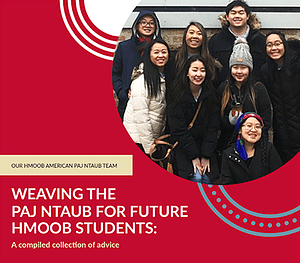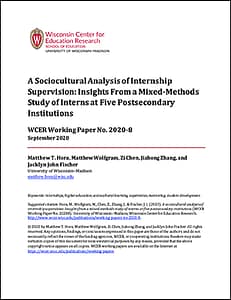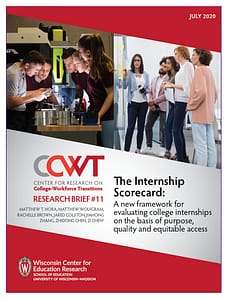Filter by Category:
Search
Year
- Category: Research Briefs
- Clear Filters
 Moua, P., Thao, A., Xiong, O., Lee, L., Smolarek, B., Vang, M. N., Wolfgram, M., Xiong, P. K., Xiong, Y. Y., & Yang, L. (2020). Weaving the Paj Ntaub for future HMoob Students: A compiled collection of advice. Wisconsin Center for Education Research. University of Wisconsin-Madison.
Moua, P., Thao, A., Xiong, O., Lee, L., Smolarek, B., Vang, M. N., Wolfgram, M., Xiong, P. K., Xiong, Y. Y., & Yang, L. (2020). Weaving the Paj Ntaub for future HMoob Students: A compiled collection of advice. Wisconsin Center for Education Research. University of Wisconsin-Madison.
Abstract: This report intends to share the knowledge and advice of current and former HMoob students who attended the University of Wisconsin-Madison. With their responses, the Paj Ntaub research team gleaned advice that these participants wished to pass along to current and future HMoob students. Through many of our interviews, participants shared advice on subjects that they themselves wished they had received during their time at UW-Madison.These responses came from 36 current students 31 former students with a total of 71 individuals and encompassed ideas around lack of familiarity with campus, making career decisions, experiences tied specifically to multidimensional identities, and stereotypes associated with attending UW-Madison. Students come to college with different experiences, goals, and expectations and this may lead to contradicting advice. In this report, we understand and want to shed light on these experiences by giving the space for each and every type of advice.

Abstract: Internships are widely promoted extra-curricular experiences that can have positive impacts on student outcomes, yet how specific elements of internships contribute to these outcomes and facilitate learning is understudied. In this sequential mixed-methods study, we use sociocultural learning theory to interpret data from surveys (n = 435) and focus groups (n = 52) with students at five postsecondary institutions. After stepwise linear regression analyses indicated that supervisor behaviors were significantly associated with intern satisfaction and career development, analyses of qualitative data revealed features of positive (clear communication, availability, feedback) and negative (unavailability, inattention to learning) aspects of supervision. These results highlight the value of legitimate peripheral participation in internships, and the need for colleges and employers to carefully design and monitor these pedagogic spaces.

Executive Summary: While internships are widely praised and promoted as a “door opener” to opportunity, the impact of these work-based learning programs on students is complicated by the variability in how they are designed, implemented and experienced. Consequently, instead of assuming that participation unequivocally results in positive academic and labor market outcomes, the field needs conceptual tools to distinguish internship programs from one another and to evaluate their efficacy, quality and commitment to equity. In this report we first review various frameworks that distinguish different types of work-based learning and internship programs, and then describe a new framework for distinguishing internships on the basis of purpose, quality and equity – The Internship Scorecard.
This new framework is based on theory and evidence from cultural anthropology, the learning sciences and work-based learning, and is designed for higher education professionals, funders, policymakers and employers so that they can – with more nuance and precision than is currently available – make distinctions between program types and begin to “score” programs at the individual-level or in the aggregate for entire institutions. An example of how the Internship Scorecard can be used in practice is provided, along with next steps for the analysis and improvement of college internship programs.
Note: We are very interested to hear any feedback that you might have about The Internship Scorecard. We are especially interested in hearing your thoughts, critiques and suggestions for how the Scorecard can be used in practice to study and/or evaluate internships.

Abstract: Internships are one of the most widely promoted co-curricular experiences for college students, and the COVID-19 pandemic and resulting shelter-in-place orders led to a substantial growth in the availability and popularity of online internships. However, little is known about the impacts of online internships on student outcomes. In this literature review we present key trends and findings from the academic and practitioner literatures on online internships. Relatively little empirical research exists on online internships, but researchers have found that pre-internship orientations, self-regulated learning, sufficient technology, and effective supervision are important for successful experiences. Our review also highlights that considerable variation exists among online internships, especially with respect to the host organization (i.e., employers or third-party vendors), compliance with standards for legitimate and high-quality internships, and duration. Ultimately, we conclude that standards articulated for “legitimate internships” by the National Association of Colleges and Employers (NACE) and for rigorous experiential learning programs by CCWT should also be applied to online and/or remote internship programs. We conclude our review with recommendations for students, postsecondary professionals, employers and higher education researchers.
